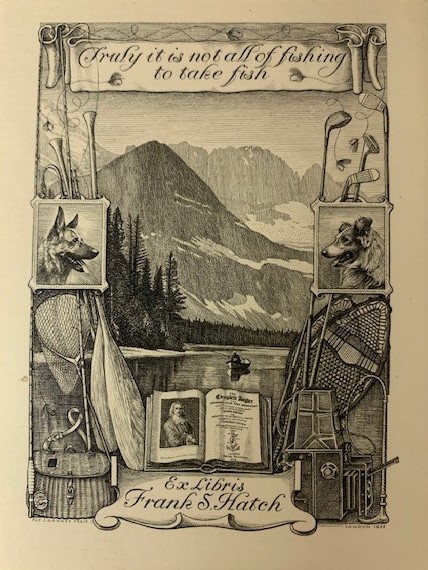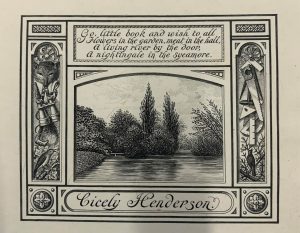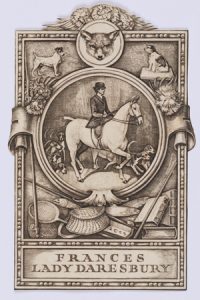Bookplate Stories: Gertrude Edlemann

This post is part of a series of stories written by Liz West, Fellow in Ephemera Studies, about the Amoret Tanner bookplate collection. Read more here
·
Story one
Mr and Mrs Edlemann
♠
If, as George Orwell proposed, the English have ‘an addiction to hobbies and spare-time occupations’, then nowhere is this is more apparent than within a collection of bookplates. The pictorial book plate, which reached its peak of popularity in the late nineteenth and early twentieth century, was a perfect canvas on which to proclaim its owner’s interests, passions and preferred past-times. The bookplate above suggests that Gertrude H Edlemann was a woman of wide and varied interests: everything from gardening and botany to poetry and literature is covered, via carving and dairy (cheese-making, perhaps?). The plate was designed in 1894 by John Williams, who also created a bookplate for Gertrude’s husband, Herbert (it featured an angling theme, with the quote ‘His line, his hook, his fish, his book’). Gertrude, the second daughter of T Dickinson Hall of Whatton Manor, Nottinghamshire, married Herbert in 1875. A newspaper report of the wedding suggests that it was quite an event:
At eleven o’clock a string of carriages from the Manor, which is about a mile from the church, betokened the arrival of the wedding party, who passed under a beautiful triumphal arch at the church gate, erected by the villagers. The carpeted walk through the churchyard was lined with crowds of villagers, and amongst them was a goodly preponderance of the fair sex, who always muster greatly on such occasions.
The Nottinghamshire Guardian, 12 February 1875
Following their honeymoon in Rome, the Edlemanns settled down to married life, and, if their bookplates are to be believed, plenty of hobbies.
·
Story two
Cricket and Golf
♠♠
Although Herbert Edlemann’s bookplate professed his love of fishing, he was also a first class cricketer, who made an appearance for the Gentleman of England in 1864 (ending the first innings not out on 13). Cricket features on a number of the bookplates in our collection: presumably chosen by keen spectators as well as participants. Here are a couple of examples:

 To carry on the sporting theme, this bookplate suggests a somewhat unhealthy obsession with achieving the perfect putt.
To carry on the sporting theme, this bookplate suggests a somewhat unhealthy obsession with achieving the perfect putt.
We don’t know anything about the troubled Arthur Sykes, but the artist who designed the bookplate in 1905 was Henry Justice Ford, an English artist and illustrator best known for his illustrations for Andrew Lang’s Fairy Books. He studied at the Slade School of Fine Art and exhibited at the Royal Academy. Coincidentally, Ford was one of seven brothers, all of whom played cricket. He played regularly with JM Barrie’s Allahakbarrie Cricket Club and this association was clearly fruitful: Ford designed Peter Pan’s costume for the play’s first staging in the West End in 1904.
·
Story three
The Art of Fishing
♠♠♠

To return once more to Herbert Edlemann. As previously mentioned, if his choice of bookplate is to be believed, he was a keen angler, and this is another popular choice of subject for pictorial bookplates. This bookplate, designed by Alfred Downy Painter, engraver and bookplate designer, for Frank S Hatch of Longmeadow Massachusetts, has an interesting detail.
Above the accoutrements of a life well lived (dogs, golf clubs, camera, paddles, fishing boat, rod and nets) there is a quotation from Izaac Walton’s The Complete (or Compleat, depending on the edition) Angler: ‘Truly it is not all of fishing to take fish’. Positioned towards the bottom of the plate is an open book: on closer examination this can be seen to be the title page of the 1986 edition of The Complete Angler, edited by Harris Nicholas and published by William Pickering. Pickering commissioned 27 of the most prominent artists, painters and engravers of the period to illustrate this edition, which is considered to be one of the finest ever published. Here is the detail, and a picture of the title page for comparison:

There is a pleasing symmetry to the thought that many copies of The Complete Angler will contain angling-themed bookplates too.
·
Story four
Women’s hobbies
♠♠♠♠
Apart from Gertrude Edlemann’s bookplate, at the start of our journey, the bookplates featured so far have all belonged to men, and, within our collection at least, it does appear that the depiction of hobbies is, with some exceptions, quite gender specific. Women’s pictorial bookplates reveal a different set of interests, including, but not limited to, gardens, painting, music, travel and reading.

 Cicely Henderson’s plate does raise some questions though – it has a curious border, depicting a set square, saw and protractor on one side, and a fox, binoculars and walking stick on the other. Cicely’s interests certainly ventured beyond flower-arranging and poetry.
Cicely Henderson’s plate does raise some questions though – it has a curious border, depicting a set square, saw and protractor on one side, and a fox, binoculars and walking stick on the other. Cicely’s interests certainly ventured beyond flower-arranging and poetry.

Another woman who chose a bookplate design to express a wider range of interests is Frances, Lady Daresbury OBE. She was a keen supporter of the Primrose League, formed by admirers of Benjamin Disraeli in 1883 to promote Conservative principles and imperialism. It was one of the first political organisations in the UK to give women the same status and responsibilities as men. Her bookplate signifies her love of foxhunting and fishing – both activities in which women could operate as equals with men.
·
Bonus Story
♠♠♠♠♠
The craze for pictorial depictions of hobbies and interests on bookplates was not universally admired, however. Joseph Gleeson White, a British writer on art, wrote a disparaging article:
“Bicycles a bit, is fond of roses, sketches a little, keeps bees, admires Egyptian art, is fond of reading, plays golf, keeps a pet kangaroo” Yet some such absurd medley of unrelated facts appears in hieroglyphics on many a plate…As well cover a house with pictorial posters announcing its inmates’ tastes, or add to a luggage label the political, social, and technological views of its owner, with a few playful allusions to his domestic habits.’
Gleeson White, The Studio Special Winter Number 1898-99: Modern Bookplates and their Designers
Gleeson White questions the logic of professing a love of reading on a bookplate that will appear in such a self-evident way: ‘to proclaim on his cycle that he cycled, or on his books that he is bookish, seems the most foolish of all.’ He ends his piece with the pronouncement: ‘to stick in one’s books these pretty, self-selected autobiographies, expressed through the medium of picture language is folly.’ This seems unduly harsh – surely it is human nature to want to express aspects of one’s personality and interests through images – witness the rise of the ‘shelfie’, popularised on social media in the lockdown era of Zoom calls, or even the preponderance of tattoos across all sectors of society. Both of these trends echo the same motivation expressed by those commissioners of pictorial bookplates over a century ago – our hobbies and passions give us a chance to express a facet of our personalities which exist beyond workplace or family.
In fact, even Gleeson White couldn’t quite resist the lure of the bookplate, and designed a series of plates for himself, family and friends. These two examples were created for Emma Chamberlayne, and his daughter, Cicely Rose:
